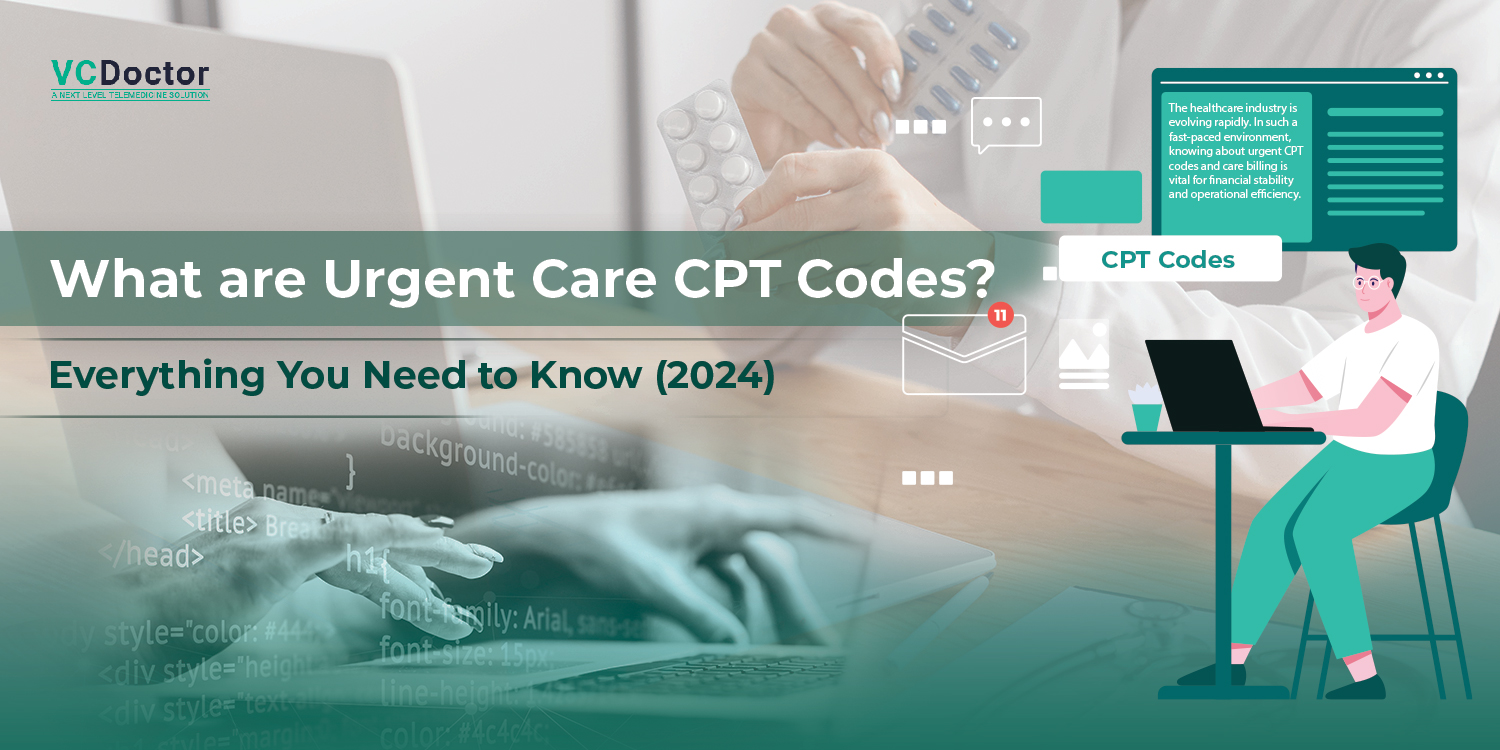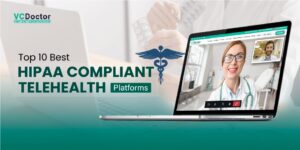What are Urgent CPT Codes, It’s Uses, Guidelines and Best Practices 2024
The healthcare industry is evolving rapidly. In such a fast-paced environment, knowing about urgent care CPT codes and care billing is vital for financial stability and operational efficiency. These guidelines efficiently explain all coding and billing complexities processes, guiding these experts about urgent care guidelines for effective problem-solving. If you are someone from the medical industry eager to know about urgent care CPT codes, we have got you covered. In this article, we will explain about urgent care CPT codes and their uses. So, without any delay, here we go!
Urgent Care CPT Code List
| Urgent Care CPT Codes | Description |
| 99285 | Emergency department visit |
| J1100 | Injection, dexamethasone sodium phosphate, 1 mg |
| 36415 | Routine venipuncture |
| 31500 | Intubation, endotracheal, emergency procedure |
| 99291 | Critical care, first 30-74 minutes |
| 49083 | Laparotomy, exploratory, with biopsy |
| 93000 | Electrocardiogram, routine ECG with at least 12 leads |
| 31575 | Laryngoscopy, indirect |
| 43239 | Esophagogastroduodenoscopy, with biopsy |
| 36410 | Venipuncture, age 3 years or older, necessitating physician’s skill |
An introduction to urgent care CPT codes
1. 99285
The emergency department visit code intends to document the highest caliber of care given to patients with serious symptoms or diseases that need to be treated immediately. It includes taking the patient’s medical history and doing an examination. It also includes making medical decisions and coordinating care. When a patient presents with potentially fatal symptoms, e&m codes are frequently utilized. These include trauma, acute, myocardial infarction, stroke and severe respiratory distress.
2. J1100 – Dexamethasone sodium phosphate injection, 1 mg
Strong corticosteroid dexamethasone is used to lower inflammation and inhibit immunological responses. In order to treat a variety of acute illnesses, such as allergic reactions, exacerbations of asthma, severe inflammation, and specific autoimmune disorders, this injection is frequently given in an emergency. In urgent conditions, it acts fast to stabilize patients and reduce symptoms.
3. 36415 – Routine venipuncture
Although not always necessary, venipuncture treatments are frequently carried out quickly in an emergency to take a blood sample for diagnostic purposes, blood transfusions, or drug delivery. This number is used to report blood drawn with a needle from a vein for a variety of urgent medical needs, such as blood cell counts, laboratory analysis of blood chemistry, and blood culture tests.
4. 31500 Emergency procedure
Endotracheal intubation entails inserting a breathing tube into the trachea to create and maintain the patient’s airway. This procedure is critical when a patient’s breathing is impaired due to respiratory failure or cardiac arrest. The emergency technique of placing an endotracheal tube to support ventilation and oxygenation is explicitly indicated by code 31500.
5. 99291 – Critical care, evaluation, and management of the critically ill or critically injured patient, first 30-74 minutes
When a patient is seriously injured or needs emergency care, this code is used. It reports the provision of urgent and intensive medical care. Patients with life-threatening diseases like sepsis and severe trauma are monitored closely. Further, they are managed with the help of critical care services. The first thirty minutes of critical care services are given in emergency rooms and intensive care units. Further, other critical care settings are covered.
6. 49083 – Laparotomy, exploratory, with biopsy(s) (single or multiple), separate procedure
A laparotomy is a surgical technique in which the abdomen is opened to allow internal organs to be examined and seen. When there is a suspected:
- Intra-abdominal hemorrhage
- Acute abdomen
- Abdominal trauma
- Unexplained pain, it is frequently done immediately
Code 49083 covers the procedure of an exploratory laparotomy in addition to the biopsy (removal of tissue samples) for diagnostic purposes. Both procedures may be required to diagnose and treat underlying diseases in an emergency.
7. 93000 – Electrocardiogram
A diagnostic test is called an electrocardiogram. It measures an electrical activity and looks for irregularities in its rhythm and function. The performance and interpretation of a standard ECG with at least 12 leads are reported through this code. When a patient presents with symptoms that point to:
- Acute coronary syndrome
- Arrhythmias
- Myocardial infarction
- Other cardiac crises
It is imperative to acquire an ECG right away in order to guide prompt intervention and treatment.
8. 31575 – Laryngoscopy, indirect (separate procedure)
Using a laryngeal mirror, indirect laryngoscopy entails examining the larynx and adjacent structures. Patients requiring this urgent surgery are:
- Suspected laryngeal disease
- Foreign body aspiration
- Vocal cord dysfunction
- Airway blockage
In urgent clinical situations, indirect laryngoscopy is performed as a distinct operation to see and assess the larynx. This procedure is reported using code 31575.
9. 43239 – Esophagogastroduodenoscopy
It is a diagnostic procedure that uses an endoscope. It is a flexible and illuminated device, to examine the stomach and duodenum. The procedure of EGD combined with the extraction of tissue samples from the upper gastrointestinal tract is reported using code 43239. In order to provide a diagnosis and direct future treatment might benefit from an urgent EGD with a biopsy. Individuals with:
- Gastrointestinal bleeding
- Suspected gastrointestinal cancers
- Severe dysphagia
- Unexplained abdominal pain
10. 36410 – Venipuncture
Venipuncture is the process of using a needle to puncture a vein to draw blood for intravenous therapy and diagnostic testing. Such operations involving individuals three years of age require a doctor’s skill and knowledge. An urgent venipuncture may be required in case of emergency to measure blood gas and electrolyte levels. Further, chemistries or to give vital drugs or blood products.
Exclusive ‘S’ Codes for Urgent Care Facilities
Whether it’s urgent care or primary care centers, both deal with the same health problems and use similar ways to bill for the services. However, urgent care uses special codes that start with the letter ‘S’. These special codes are unique and part of the Healthcare Common Procedure Coding System (HCPCS) and used by many healthcare providers. Here are some of the exclusive ‘S’ CPT codes for urgent care, including:
S9083
S9083 is a special code which is used to bill for all types of service provided via urgent care centers. No matter how minor or major the treatment is, it charges a single (all-inclusive) fee to cover everything. Mostly this code used when hospitals are billing and offense includes Managed Care Organizations (MCOs) to handle the payment, where MCOs play a crucial part in states like Florida and Arizona, may mandate using this code when charging for services.
S9088
The use of this special code S9088 is used by urgent care centers while billing for checking and treating medical conditions. They use this code with another code to cover patients exams and management (E/M code). It helps the urgent care centers to increase the cost needed for providing immediate care.
These exclusive ‘S’ codes like S9083 and S9088 play a crucial role for billing in urgent care centers and these codes are used for most urgent care visits. While medicare uses different codes as per their patients needs and location.
Essential Elements of Urgent Care Billing and Coding
Here are some vital urgent care cpt codes and bills are as follows:
1. Precise Patient Data
Some major cornerstones of efficient billing are:
- Accurate patient data collection
- Encompassing personal information
- Insurance coverage
- Verification
This step is essential to guarantee that payers are correctly directing and processing claims.
2. Extensive Recording
Clinical documentation needs to be extremely thorough, recording the cause for the visit, the services rendered, any operations carried out, and the results. This evidence, which backs up the CPT billing codes used, justifies claims to insurance companies.
3. Appropriate Coding
It’s critical to use the correct codes from the Healthcare Common Procedure Coding System (HCPCS), International Classification of Diseases (ICD-10), and Current Procedural Terminology (CPT). These codes communicate the services rendered to insurance firms. Errors or discrepancies that result in claim denials are less likely when correctly coded.
4. Use of Modifiers
In medical coding, modifiers are employed to signify any modifications or particular circumstances pertaining to a service rendered, but they do not modify the definition or code of the service. In order to guarantee correct reimbursement for urgent care bills, it is essential to understand when and how to utilize modifiers.
5. Knowledge of Payer Policies
It’s important to comprehend the many insurance payer policies, such as those offered by Medicare, Medicaid, and commercial insurers. By filing claims that meet each payer’s guidelines, this knowledge reduces the likelihood of delays and denials.
Updates to Urgent Care CPT Codes in 2024
In 2024, there are some recent updates made in urgent care CPT codes with the aim of simplifying the billing and claim accuracy. Here are the recent updates:
Introduction of New CPT Codes: Several new CPT codes have been added for catering the emerging medical technologies and techniques.
Revisions to Existing CPT Codes: Existing codes have been updated to better align with the current medical practice and technological improvements.
Deletions: Outdated CPT codes have been removed to keep the CPT coding system up-to-date and relevant.
Common Mistakes in Urgent Care Billing and How to Avoid Them
Here are some most common mistakes in urgent care billing:
1. Erroneous Coding
Claims denials or underpayment may result from using inaccurate new patient CPT codes or modifiers. Make sure the codes appropriately reflect the extra procedures carried out, the complexity of the visit, and the services rendered. Staff workers can reduce coding errors and keep informed by regular training and coding principles updates.
2. Inadequate Recording
Failure to adequately document patient contacts may lead to audits or claim rejections. All pertinent information, including as the patient’s primary complaint, medical decision-making, history of current illness, system evaluation, physical examination results, and any operations carried out, should be meticulously documented by providers. Prompts and templates for electronic health records (EHRs) can help assure completeness and streamline documentation.
3. Upcoding
It is the practice of billing for services at a level. It exceeds what is reasonable, given the patient’s condition or the complexity of the visit. Parts of a procedure that ought to be invoiced as a single code are independently billed in an unbundled process. Charges of abuse or fraud may result from either technique. Make sure that the billing procedures follow the guidelines for medical necessity and fairly represent the quality of care rendered.
4. Lack of prior authorization
Reimbursement delays or claim denials may arise from the failure to acquire prior authorization for specific treatments or services. Before beginning non-emergent operations or placing an order for diagnostic testing, confirm insurance coverage and authorization requirements. Train employees on the significance of compliance and establish explicit procedures for gaining prior authorization.
5. Failure to verify insurance coverage
Billing problems and claim denials may arise from failing to confirm patients’ insurance coverage and eligibility before providing services. Prior to every patient visit, put policies in place to confirm insurance coverage, copayments, deductibles, and referral requirements. To expedite the verification process, make use of internet portals or electronic eligibility verification tools offered by payers.
6. Inaccurate time-based service documentation
Time-based services, like extended evaluation and management (E/M) or critical care, require precise timekeeping of the entire amount of time dedicated to direct patient care. Providers must record the start and end timings of these services, together with the tasks completed during the patient’s visit. Proper use of time-based modifiers and codes to indicate how long the care was given is also essential.
7. Failing to record further services
If all billable services rendered during a patient visit are not recorded, there may be financial loss. Put in place mechanisms to guarantee that all provided services, treatments, materials, and drugs are appropriately recorded and invoiced. Examine encounter records and coding procedures on a regular basis to find any lost chances for compensation.
8. Inadequate staff training
Inadequate training for billing and coding staff might result in errors in paperwork, coding, and claim submission. Invest in continuing education and training for employees who handle revenue cycle management, coding, and billing. Give staff members access to materials like code manuals, webinars, and workshops so they can stay informed about best practices, regulatory updates, and coding requirements.
Impact of Regulatory Changes on Billing
For urgent care providers, it’s important to know how new regulatory changes can impact the billing system. Here’s how these regulatory updates can affect the practice:
Billing Accuracy: All the updated CPT codes required careful and correctly added to the billing system in order to avoid any mistakes and prevent denied claims.
Reimbursement Rates: Changes in CPT codes can also impact how much an urgent care provider is paid. So you need to adjust your billing methods and ensure to use the right CPT codes for maximum revenue.
Compliance: Using the latest CPT codes is very important because it can help you avoid fines or legal disputes. So, it’s a good idea to keep training your staff with CPT codes and stay up-to-date with the changes.
5 Best Practices and Tips for Urgent Care Billing Codes
1. Keep up with coding requirements
Stay up to date on changes to the International Classification of Diseases and Healthcare Common Procedure Coding System codes. Examine coding manuals and newsletters to guarantee adherence to coding requirements and precisely record services rendered. You must also examine all internet resources on a regular basis.
2. Apply E/M guidelines suitably
Learn about the Centers for Medicare and Medicaid Services Evaluation and Management Documentation Guidelines. Make sure that all of the documentation, such as:
- History
- Examination
- Medical judgment
- Time spent
3. Record Medical Necessity
Clearly record the cause for the visit, the symptoms, the diagnosis, and the treatment plan, together with the medical necessity of each service rendered. In order to validate the need for services and prevent claim rejections or audits, medical necessity is a prerequisite.
4. Code to the Highest Specificity
Give codes the maximum degree of detail that the accompanying documentation permits. Make use of precise procedure codes (CPT/HCPCS) and diagnosis codes (ICD-10) that appropriately reflect the patient’s condition and the services provided. Steer clear of undefined codes whenever you can.
5. Train Employees on Appropriate Coding Procedures
Thoroughly train and instruct employees involved in the coding and billing processes. Ensure that the administrative staff, coders, billers, and providers are aware of the documentation needs, coding norms, and the significance of proper coding for compliance and payment.
Planning for Building HIPAA-Compliant Telemedicine Software?
Wrapping Up!
Knowing the details of medical coding and billing has become vital in this time and medical age. The patients need to remain healthy while maintaining their finances properly. Since understanding the urgent office visit cpt code is not easy, you may rely on the urgent care billing companies that specialize in Healthcare Revenue Cycle Management. You may get in touch with experts at VCDoctor.
FAQs
1. What does CPT code 99205 mean?
99201- 99205 CPT code varies from minimal to deep evaluation based on overall time spent and complexities.
2. Mention the best practices to apply CPT codes in urgent care billing
To minimize denials and maximize reimbursement, urgent care centers must follow best practices such as:
- Documentation to support the chosen codes
- Latest coding guidelines
- Regularly training staff
3. Which code is assigned to an urgent care?
The exact code for an urgent care visit is determined by the degree of Evaluation and Management (E&M) services provided; for outpatient appointments, this code ranges from 99201 to 99215 CPT code description. Additional procedure, diagnostic, and modifier codes may also be applied if relevant.
4. What CPT codes are billed for urgent care?
CPT codes include:
- 99201-99205: Evaluation & Management of New patient CPT code.
- 99211-99215: Evaluation & Management of Established Patients.
- CPT code 12001-13160: Wound Repair.
- 10060-10180: Incision & Drainage.
- 20525-20553: Foreign Body Removal.
- 29000-29799: Splint and Cast Applications.
5. What modifier is used for urgent care?
Modifier 25 is used for urgent care.




